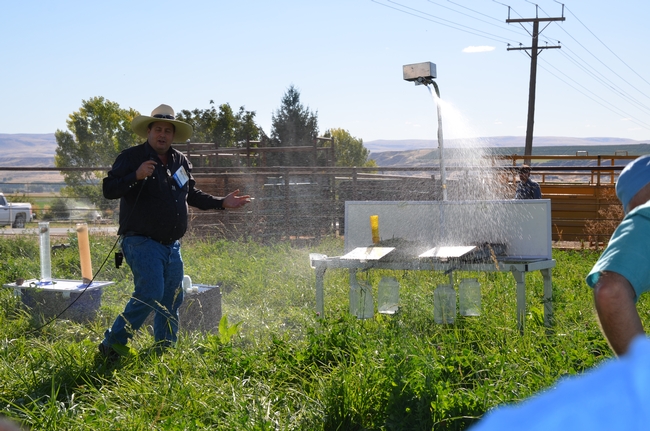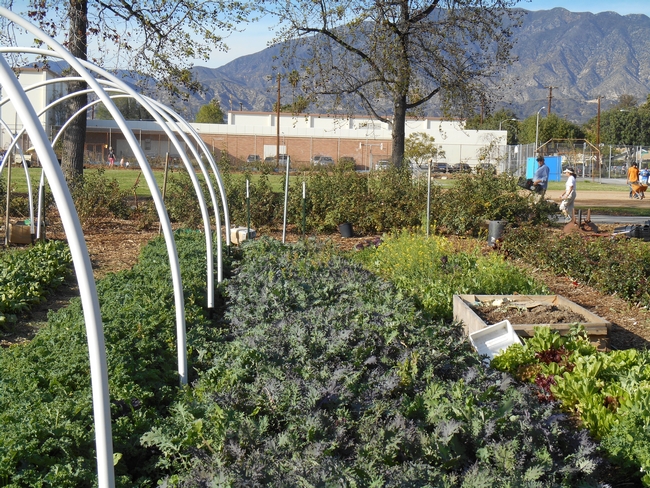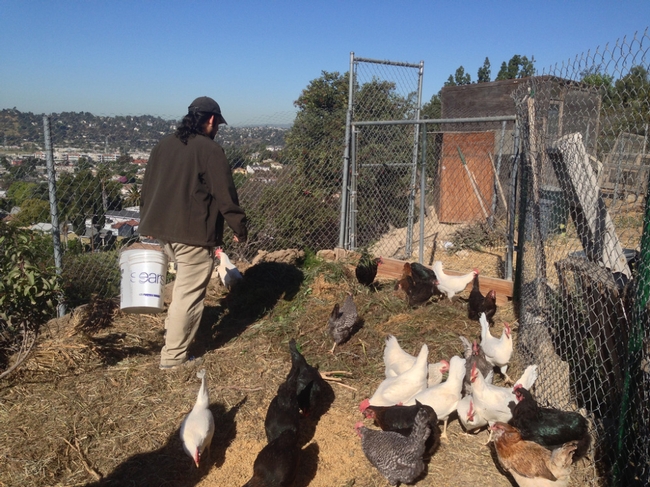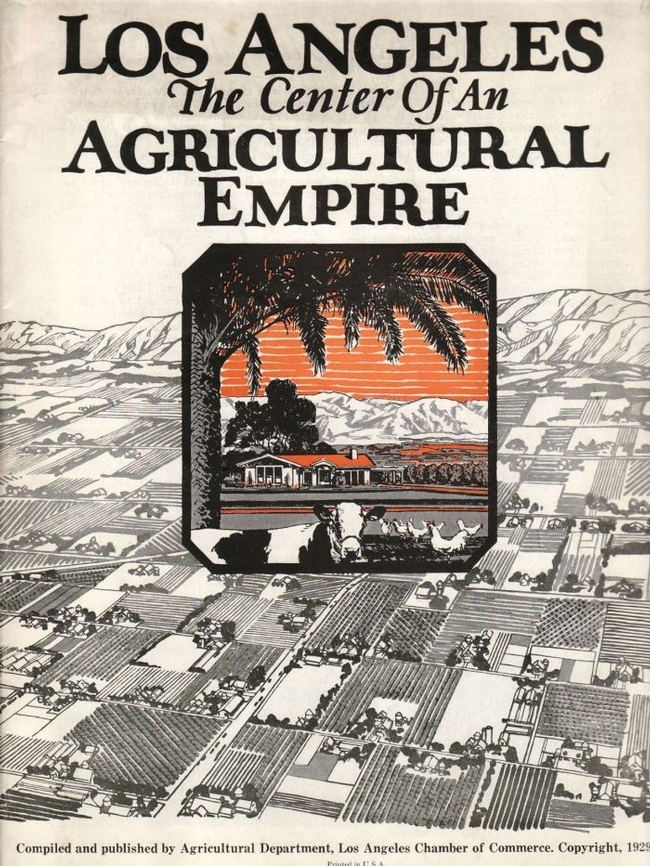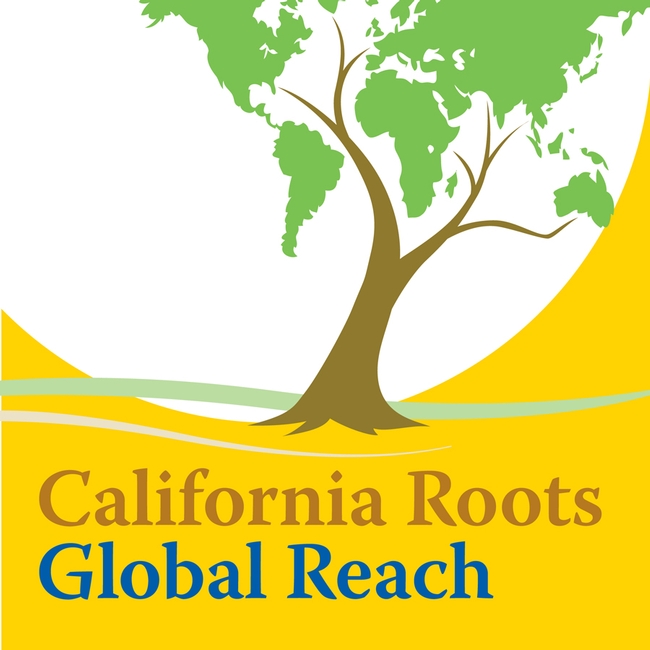Posts Tagged: food systems
California Farm Demonstration Network forms to foster farmers’ innovation
Innovation is key to keeping California farmers globally competitive. On Friday, May 5, the California Department of Food and Agriculture, California Farm Bureau Federation, California Association of Resource Conservation Districts, USDA Natural Resources Conservation Service, UC Davis and UC Agriculture and Natural Resources will forge a formal agreement to better connect the state's farmers with each other and with science-based information sources to assure the sustainability of the state's agricultural systems. Representatives of the six organizations will sign a memorandum of understanding (MOU) to form the California Farm Demonstration Network.
The scarcity of water, fossil fuel use, carbon emissions, groundwater quality, labor cost and availability, air quality and loss of soil fertility are some of the challenges to the long-term viability of farming in California. Soils and their sustained health play a major role in keeping California's agriculture viable for future generations.
“What we are striving to accomplish with the California Farm Demonstration Network is to create a means for farmers to learn, to discover and to innovate,” said Jeff Mitchell, UC Cooperative Extension cropping systems specialist, who is leading the effort with technical and funding assistance from MOU partners.
WHO:
- Karen Ross, secretary of the California Department of Food and Agriculture
- Paul Wenger, president of the California Farm Bureau Federation
- Ron Tjeerdema, associate dean of UC Davis College of Agricultural and Environmental Sciences
- Glenda Humiston, University of California vice president for Agriculture and Natural Resources
- Karen Buhr, executive director of California Association of Resource Conservation Districts
- Carlos Suarez, state conservationist for USDA Natural Resources Conservation Service
WHEN: Friday, May 5
12:30 p.m. to 1 p.m. – Demonstration of differences in soil function resulting from management practices.
1 p.m. to 2 p.m. – Network partners describe their respective roles.
WHERE: Dixon Ridge Farms, 5430 Putah Creek Road, Winters, CA
VISUALS: A rainfall simulator will spray water over trays of different soils to show how on-farm management practices help the soil hold together.
Network partners will sign the memorandum of understanding.
BACKGROUND:
The statewide farm demonstration network builds upon and connects efforts across California including one created in Glenn County last year.
In Glenn County, the farmer-driven effort has provided the opportunity for local farmers to share innovative practices and hold honest discussions about opportunities and challenges related to these systems.
“The collaborative effort of the partners presents the opportunity to leverage resources based on local needs and increases the likelihood that innovative agricultural practices will be adopted sooner than they might have been without the networking opportunity,” said Betsy Karle, UC Cooperative Extension director in Glenn County.
With the California Farm Demonstration Network, the organizers hope to create more opportunities to connect local people, showcase existing farmer innovation, engage in new local demonstration evaluations of improved performance practices and systems, evaluate the demonstration practices, and share information with partners. They also hope to expand and connect other local farm-demonstration hubs throughout the state via educational events, video narratives and a web-based information portal.
UC launches urban agriculture website
As local food has gained popularity, more city folks are growing food in their own backyards. Now they have a new online resource to consult about urban farming. The University of California Division of Agriculture and Natural Resources has launched a website to provide practical, science-based information for urban agriculture.
At the website at http://ucanr.edu/urbanag, visitors will find information on raising livestock, crop production, marketing and policies for farming in their backyards, on a few acres, at a school or in a community setting.
Rachel Surls, a UC Cooperative Extension advisor in Los Angeles County, and a team including UCCE farm advisors, policy and advocacy experts, urban planners, agricultural economists and others created the new urban agriculture website in response to the results of a UC survey of urban farmers in California.
“Our team interviewed urban farmers around the state about their challenges and successes, and what information they really needed as they got started,” said Surls, who specializes in sustainable food systems. “Based on their needs, we looked for science-based educational materials that would be helpful and packaged them into this website.
Many urban farmers are beginning farmers, according to Surls. “They need basic information on planting, pests and irrigation, as well as information that's more specific to farming in the city,” she said. “For example, they must navigate local laws and regulations that impact farming which include zoning and health codes.”
The UC ANR Urban Agriculture website also advises urban farmers about environmental issues that they may encounter.
“Urban soils can sometimes be contaminated and may need testing and remediation,” Surls said. “Farming close to neighbors in the city can also bring special challenges.”
She encourages people to check back for updates as the Urban Ag website continues to grow.
“We'll also share stories about urban farms around California and news around the state about urban agriculture policies and initiatives,” Surls said.
Visit the UC ANR Urban Agriculture website at http://ucanr.edu/urbanag.
UC collaboration helps position LA urban agriculture for growth
Until the early 1950s, Los Angeles was an agricultural powerhouse as the top farm county in the nation for decades, producing a wide array of fruits and vegetables as well as milk and other farm products. The University of California maintained a large Cooperative Extension office in Los Angeles County to work with local farmers. In the following years, as land was developed, farming declined precipitously. Today, one UC Cooperative Extension farm advisor works with Los Angeles County commercial farmers, who are mostly located in the rural high desert around Lancaster.
More than half a century after its decline, agriculture has again become high profile in Los Angeles County, although the focus has shifted from rural to urban. Urban agriculture has gained momentum in the county, as it has in many metropolitan centers throughout the United States, with a growing number of small-scale city farmers, along with enthusiastic backyard beekeepers and poultry raisers. However, despite the apparent popularity of urban agriculture, a clear picture of its status in the county did not exist until very recently.
A new UCLA student report, “Cultivate LA,” was released on Aug. 15 and offered the first comprehensive picture of the local urban agriculture landscape. The report provides an important foundation for UC Cooperative Extension and other groups involved in developing policy and educational resources for urban farmers.
According to Rachel Surls, UC Cooperative Extension sustainable food systems advisor in Los Angeles County and the “client” of the student project, the report has generated tremendous interest. The students verified a total of 1,261 urban agriculture sites using a variety of data sources, and confirming sites with telephone calls and Google Earth. They looked closely at issues such as complex zoning codes that impact urban farming and the distribution of its products. As one of their final products, the students created a website (www.cultivatelosangeles.org) that contains an interactive map and a chart of agriculture zoning codes in each of the county’s 88 cities and its unincorporated areas.
Surls became involved in urban agriculture policy beginning in 2011, through her participation in the Los Angeles Food Policy Council. Due to the lack of information at that time, the task of crafting policy was a challenge. So, when UCLA faculty members offered to have urban planning graduate students produce a comprehensive report on urban agriculture in Los Angeles County, guided by her input, Surls embraced the opportunity. With Carol Goldstein, lecturer in urban planning, and Stephanie Pincetl, professor and director of the California Center for Sustainable Communities at UCLA’s Institute of the Environment and Sustainability, Surls helped the students develop their research questions and directed them towards important sources of data.
Surls points out a few relevant findings that will guide her work in further developing UC Cooperative Extension’s program in sustainable food systems.
School gardens are the most common form of urban agriculture. In Los Angeles County, there are more than 700 verified sites. The report suggests that more resources and training are needed to ensure that gardens are successful and integrated into the school curriculum. Surls plans to update resources for school gardens in the next few months.
Urban farmers face major challenges. They find it hard to compete with rural farmers. Their small growing spaces make it difficult for them to produce fruits and vegetables that are competitively priced with those produced on large rural farms.
“Also, urban farmers have to learn from the ground up,” said Surls, who plans on creating an online database of resources and best practices for urban farmers. "Often, they don’t know where to start and don’t realize they are entering a very complex business.”
Despite some challenges, urban farmers can enjoy advantages. Some have access to free or low-cost land if they operate within a public agency or nonprofit setting. Surls is currently developing resources that will help urban farmers test their soil and identify and mitigate problems, such as lead contamination. She also hopes to partner with nonprofit agencies to evaluate vacant lands for their suitability for farming.
Surls is currently leading a project that is assessing the needs of urban agriculture throughout the state. She is excited to see how the results of the UCLA student report will dovetail with the results of the statewide assessment.
“What’s happening in Los Angeles is mirrored in cities around California,” said Surls. "The public is enthusiastic about urban farming, and municipalities are struggling to find models that work in California’s urban communities. Both of these projects can help planners and citizens make common-sense decisions and help current and future urban farmers become successful.”
To learn more about the UCLA student project, visit http://cultivatelosangeles.org. For more information on UC Cooperative Extension’s sustainable food systems program, please visit http://celosangeles.ucanr.edu.
UC Global Food Systems Forum to address challenges of feeding the world
The University of California, through its Division of Agriculture and Natural Resources, will convene some of the world’s leading experts April 9 at the Global Food Systems Forum to address how to sustainably feed 8 billion people by 2025. The discussion will bring together people from a dynamic range of disciplines, including farmers, researchers, policymakers, economists, environmentalists and geopolitical experts. The general public can view the event live by webcast.
The daylong forum, part of ANR’s Statewide Conference in Ontario, Calif., will feature two moderated panels and keynote addresses by Mary Robinson, former president of Ireland and president of the Mary Robinson Foundation – Climate Justice, and Wes Jackson, founder and president of The Land Institute.
Michael Specter, global issues writer for The New Yorker magazine, will moderate the first panel, which will focus on the geopolitical, ethical, economic, environmental and technical challenges facing food systems from a global perspective. Award-winning author and journalist Mark Arax will moderate the second panel, which will address the implications, responsibilities and innovative opportunities from a California perspective.
The panelists will include a mix of UC and non-UC experts and thought leaders. View a list of speakers at http://food2025.ucanr.edu/Speakers.
“As a public research university, we’re a recognized leader in tackling the world’s toughest challenges,” said Barbara Allen-Diaz, UC vice president for agriculture and natural resources. “Building on our expertise in agriculture and finding practical, science-based solutions, it falls to us to convene these sorts of conversations and look far beyond the borders of our campuses. Only through discussions of this nature will people find the common ground to move the world forward on what is a compelling, complex and crucial issue.”
The general public is encouraged to view the live webcast and join the conversation on Twitter by following (hashtag)Food2025. To learn more about the UC Global Food Systems Forum and to sign up to view the webcast, visit http://food2025.ucanr.edu.
Food forum at a glance
- WHAT: Live webcast of UC Global Food Systems Forum at http://food2025.ucanr.edu
- WHO: World-renowned leaders in food systems dialogue. See a list at http://food2025.ucanr.edu/Speakers
- WHEN: April 9, 2013 (9 a.m.-5 p.m. PDT)
- WHERE: Register for the webcast at http://food2025.ucanr.edu/Webinar
Selective dairy breeding could help prevent lameness, boost productivity
"Most dairy breeding programs select for milk production but the results of this study indicate that the cow's conformation, particularly in terms of hoof health, also should be considered," said Anita Oberbauer, professor and chair of the UC Davis Department of Animal Science and lead author of the study. The study is published in the October issue of the Journal of Dairy Science.
By reducing hoof-health problems through selective breeding, dairy producers could increase herd longevity, improve milk yield and reduce economic inputs and environmental impacts related to raising replacement heifers, the study concludes.
Oberbauer noted that lameness and hoof health are also animal welfare issues that can cause dairy producers to cull, or retire, cows early from their milking herds. As of 2011, an average of more than 40 percent of California dairy cows were culled annually, and lameness was one of the top three reasons for culling.
The 29-month study, conducted on three California dairies, correlated milk-production records with weekly observations of hoof health problems for more than 5,000 cows, including those that were visibly lame and those that were "dry," or finishing their milking cycle.
Recorded lameness-related hoof conditions included white line disease, sole ulcer, other claw horn lesions, foot rot and foot warts.
Foot warts were the most prevalent of the ailments, occurring in more than 17 percent of the monitored cows. The research also demonstrated a sizable genetic component to sole ulcer and foot warts, indicating that a breeding program directed at reducing hoof disease will likely lead to measurable improvements.
The study concluded that a breeding program that considers hoof-health traits would be unlikely to jeopardize the cows' milk productivity.
Oberbauer said that further study is now needed to identify the specific genes or DNA regions that are responsible for hoof-health traits.
UC Davis has helped to make California the nation's largest dairy state, contributing to better sanitation procedures, improvements in raw milk handling and quality, and innovations that have reduced the environmental impact of livestock waste. The J-5 vaccine alone, developed in 1988 by veterinary medicine faculty to prevent mastitis in dairy cattle, saves producers $11 million annually. Faculty research carried out at UC Davis also helped eradicate bluetongue virus in parts of the United States and rinderpest in much of Africa. Both diseases affect livestock.
Collaborating researchers on this study included Steven Berry, a Cooperative Extension dairy management specialist, staff researcher Janelle Belanger, alumna Rachel Goldrick and Professor Thomas Famula, all of the UC Davis Department of Animal Science; and Juan Manuel Pinos-Rodriguez of Instituto de Investigacion de Zonas Deserticas, Mexico.
The W.K. Kellogg Endowment and the University of California's Agriculture and Natural Resources division funded the study.

